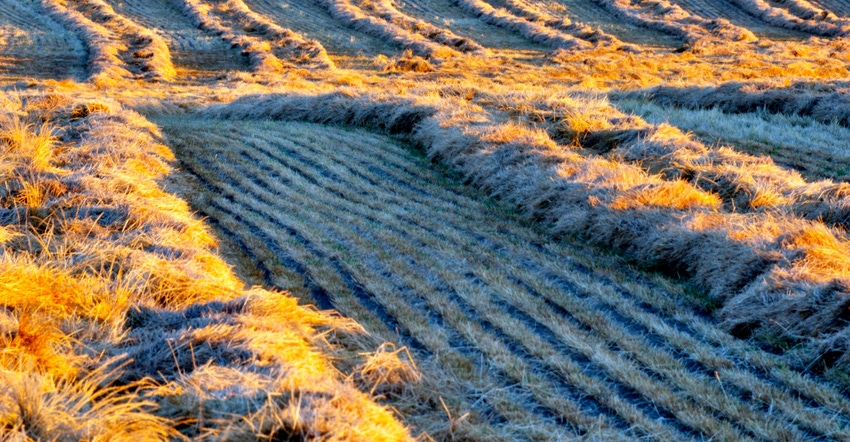April 17, 2019

By Thomas Kilcer
Winter forage harvested at flag leaf stage can add between 2 and 4 tons of dry matter per acre to the feed supply before the leaves are even on the trees. Unfortunately, much of this winter forage was not planted, or was planted very late, due to last fall’s wet weather.
Later-planted forage will still give you a crop, but yields will be down.
Right after winter forage harvest — literally within a day or two — comes the cool-season grasses. Fertilized with nitrogen and sulfur, they will take advantage of the cool, moist conditions and can produce high yields of quality forage that can sustain top milk production.
Timing is everything
Most farms don’t harvest grasses in time. Jerry Cherney of Cornell has found that stands of grass will be ready to harvest when alfalfa is only 13 inches tall. This is when grass is at an optimum stage for top forage. The timing is often a couple of weeks ahead of alfalfa, so you need to be ready. South-facing, well-drained fields will be ready before north-facing, wetter fields. You can delay harvest for higher yields, but it will come at the price of forage quality and milk per ton.
Immediately topdress after first cutting to take advantage of the cool spring and early summer weather, and to get another harvest of milk-quality forage before the hot weather hits.
For rapid regrowth, set the cutter bar at 4 inches. Cutting closer than this will devastate the next grass stand.
If summer is cool and wet, these management steps can continue and will give you a tremendous amount of forage from grass. One farm I worked with had nearly all grass fields. With a cool, wet summer and the management steps we listed, the farmer was only able to harvest half of the acreage but got the cows’ full feed supply through timely cutting and repeat fertilization. Bottom line: Don’t underestimate or overlook grass.
More options
Seeding a legume with forage oats can provide another yield boost. This is not always the preferred method for seeding but doing this with an oat nurse crop will give you several tons of high-quality forage if cut at boot stage in late June.
In this case, we suggest a forage-type oat for maximum yield potential. Set the cutter bar height at 4 inches to leave as many leaves and re-growth points on the alfalfa-clover under crop. What you potentially lose in oat forage you gain in new seeding growth.
Some farmers are thinking of planting brown midrib (BMR) sorghum Sudan or Sudan grass as emergency forage for an early harvest. We have done extensive research on this in the past and although I am very positive on these crops, I don’t suggest you go in this direction. The main reason is that you will lose one to two months of early growing season as all sorghum species need warmer soils. In the Albany area, we have had to delay planting until June 15 some years because of cool, wet conditions.
In addition, the lack of proper planting and harvesting equipment, plus having to deal with a crop you have limited experience with, is not an additional risk you want to deal with in an already tough year.
Short-season corn
So, what is the most practical option? For most farmers, a very early planting of short-season corn is the answer. Farmers know how to grow corn, and corn can grow at a soil temperature of 55 degrees F. No-till would be even better because you don’t have to wait for the whole soil profile to dry, just the top 4 to 5 inches.
Based on research I have done, you need to boost seed population. Early corn varieties are developed by shortening the vegetative stage. This tends to produce a shorter stalk, and shorter stalks mean less yield. Having more stalks per acre will make up for this and will maintain yield and standability.
We have planted 82-day corn the end of April in Albany and had 18-tons-per-acre of corn silage by August.
Don’t stop with corn
Follow the short-season corn by incorporating manure. Then, plant 100 pounds of oats — grain type, not forage — and 80 pounds of triticale per acre. The oats will be harvested at boot stage the end of September. If you mow it correctly, the
triticale will rapidly re-grow and give you an additional harvest next spring. Don’t mow shorter than 4 inches or you will have a bare field with no winter forage.
So, from the same acreage you get a corn silage crop, an oat forage crop and a winter forage crop the next spring. You can grow a full-season corn, but you will not have a corn silage harvest to add to your forage supply by the beginning of August.
If you don’t want the winter forage, just plant oats. If you are taking the oats at headed stage for lower-production animals or heifers, you may need to watch manure application rates to prevent lodging.
Kilcer is a certified crop adviser in Kinderhook, N.Y.
You May Also Like




